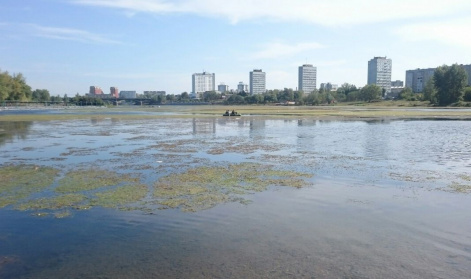On the World Water Day, a scientist of KSC SB RAS told about the biggest problems of fresh water bodies
23 March 2021 г.

The scientist gave an expert assessment of scientific articles over the past five years on water problems and highlighted the areas which the largest number of papers deal with.
WATER BLOOMING WITH ALGAE
“Over the last five years, the most cited scientific papers on water have covered five topics. One of the first places belongs to the studies devoted to water reservoir blooming with cyanobacteria. The uncontrolled development of cyanobacteria is characteristic of freshwater lakes, which often serve as a source of water for humans. Although now the rapid growth of other microalgae and its consequences start being widely considered. It is worth remembering the blooming of water in Kamchatka last year. There were dinoflagellates, which resulted in harmful consequences for people and ocean inhabitants, ” said Yegor Zadereev.
The scientist noted that the blooming of continental water reservoirs is primarily associated with global warming and the flux of nutrients: phosphorus and nitrogen.
“Baikal is also characterized by the appearance of a large number of microalgae. However, these are not cyanobacteria, but filamentous green algae. They also respond to warming and nutrient fluxes. The problem of cyanobacteria is extremely relevant for the southern regions of Russia. ”
According to the scientist, the appearance of algae reduces the quality of water and its saturation with oxygen, and in the case of the release of toxins, the water may become unsuitable altogether for any purposes. Scientists cited data that in Russia they are also beginning to more often record the rapid development of microalgae, including cyanobacteria. Blooming was observed in water reservoirs of the Volga and in the northern Krasnoyarsk reservoir on the Yenisei.
“Despite all the measures to fight microalgae in Europe, as well as in Russia, the urgency of the problem is growing. The spring peak of microalgae development is now observed earlier. The water column warms up and remains so for a longer time. The content of carbon dioxide in the air and water is increasing. All this affects water blooming, ” said the researcher.
TOO MUCH SALT
“In many northern countries, and for Russia this is also important, one of the main sources of salting water is reagents, including salt, which are used to fight ice on the roads. In the USA and Europe, salinization of water bodies was noticed after decades of using similar mixtures. Not only do these mixtures directly enter water, but they can also accumulate in the groundwater, ” added the scientist.
He explained that salts can enter a nearby lake through the system of groundwater.
“Everything that is located within the boundaries of the drainage basin comes into the reservoir and the concentration of ions of chlorine, sodium, calcium and other elements grows. Of course, this is not an extremely high salt content. But even a small increase in salinity can affect the biota of the reservoir. In addition, the ion content standards for drinking water are quite low. By adding salt to the reservoir, we are approaching this threshold, ” said Zadereev.
According to the scientist, in the north, salt, which is sprinkled on roads, mainly gets into water bodies. In the south, the increase in the salt content is due to agricultural fertilizers. Erosion or industrial activities such as mining can also increase the amount of salt in the water. Also, due to climate change, the balance of precipitation and evaporation in steppe landscapes is disturbed, this can cause rapid salinization of water bodies.
LOSS OF BIODIVERSITY
“Two years ago, the report of the Intergovernmental Group on Biodiversity and Ecosystem Services was issued, which presents global trends in the reduction of biodiversity in different ecosystems. This report notes that terrestrial ecosystems, lakes and rivers are among the most affected. On the other hand, we know very little about the biodiversity of these systems and are now losing them before we have had time to understand something, ” said Zadereev.
As the scientist noted, the biodiversity of aquatic ecosystems has been so little studied that it is extremely difficult to predict unambiguous trends even for one macroregion. Of course, experts are primarily concerned about the fate of species in hot spots of high biodiversity, in the tropics and the Mediterranean. Although in Russia there are reservoirs with a large number of unique species as well such as lake Baikal or the Caspian Sea, and even in the “ordinary” lakes of Khakassia, scientists annually find new types of microorganisms.
It is believed that the decline in biodiversity will lead to changes in the properties of water bodies. They may no longer be a source of clean water or biological resources. However, it is still difficult to identify critical thresholds for biodiversity loss. There is a risk for us to become able to understand the value of some species only after they have disappeared.
MICROPLASTIC AND ANTIBIOTICS
“This topic is of great interest now. We found microplastics, so let's study it. What is microplastics? This is something new that humans have brought to aquatic ecosystems. However, in addition to microplastics, we introduce many other compounds into water bodies which are unknown to nature. These are both nanoparticles and drugs. An important topic, in my opinion, is the pollution of ecosystems with antibiotics and the appearance of genes there, and not to mention, their carriers which are antibiotic-resistant microorganisms, ” Zadereev said.
He pointed out that articles dealing with the assessment of the content of antibiotics in water are typical for China, the USA, and Europe.
“It is clear that even if antibiotic resistance grows in natural ecosystems, it grows even more in bacterial strains that come into direct contact with these compounds, for example, in hospitals. With good reason, scientists around the world are sounding the alarm, ” the expert noted.
Share:
